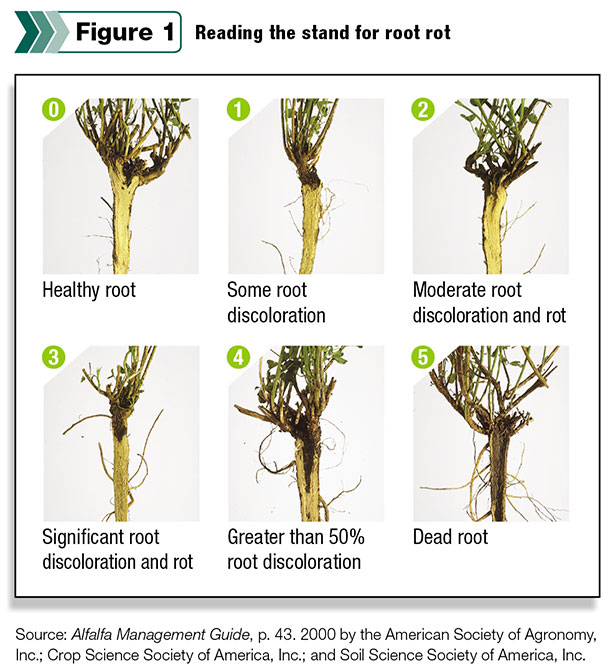How do you get the most out of a stand and when do you decide a stand should be rotated? How do you keep yields high and increase the alfalfa’s feeding value for your dairy herd or other ruminant animals?
In addition to choosing the best seed genetics and crop protection products, careful scouting through the life of the stand and strategic protection will help make your alfalfa crop the best it can be.
We are making steady improvements in alfalfa genetics, and new biotech products are expected to be available soon. No matter what type of alfalfa you plant, be sure you’re getting the most from your investment.
There are a number of ways you can maximize your crop return investment. One of the advances is reduced-lignin alfalfa with Roundup Ready technology.
As we move into a new era in alfalfa, remember the basics – the building blocks that create a good stand and keep it going strong. We still need to fertilize the soil. Lime and the correct pH remain critical. We still need to control and minimize damage from insects. We may still need to fight diseases. And we still need to manage alfalfa with high-yield techniques, choosing the right variety for each situation.
Selecting seed genetics that improve both forage yield and quality is more important than ever.
Establishing and protecting the stand
Plan to replace about 20 to 30 percent of your alfalfa stand each year so new stands are always coming into production. For optimal stand density, 55 stems per square foot is the goal. Less than 40 stems per foot indicates the stand should be replaced.
The science behind stand density says we need to have enough stems in each square foot to capture maximum sunlight and turn it into dry matter to produce feed.
Fertility is still one of the easiest tonnage-increasing variables, but one farmers tend to miss. Testing soil and plant tissue can help ensure you have good soil pH and adequate levels of potassium, phosphorus, sulfur and boron.
When establishing a new stand, it’s not about how many seeds you put in the ground; it’s about how many seeds grow into harvestable plants. Nothing is more critical to productivity than the first 30 to 60 days after seeding.
Once germination occurs, the seedling must survive, emerge and establish before it can grow into a healthy, persistent alfalfa plant. A significant percentage of seedlings can die under most field conditions.
Aphanomyces root rot is one of the fastest-spreading diseases in the Midwest. It typically occurs in saturated soils and is aggravated by soil compaction. The disease is sometimes misdiagnosed as herbicide damage. It’s an example of how diseases can adapt and become damaging to alfalfa plants in certain conditions.
Resistant alfalfa varieties were introduced in the 1980s, but within a decade, a more destructive strain of Aphanomyces (race 2) was identified and is now prevalent in the upper Midwest. A third strain has appeared on some Wisconsin farms. Seed treatments are available to protect vulnerable seedlings from soil pathogens.
If you don’t have a plan for insect control, you could lose the top end of yield potential. Sweep nets are a good investment, and your agronomist should be scouting fields at least weekly during peak production season.
In the upper Midwest, potato leafhoppers can steal yield and quality. If leafhopper populations exceed the threshold in 2-inch alfalfa regrowth, apply an appropriate insecticide to avoid significant damage. Some alfalfa varieties have good resistance to leafhoppers.
Alfalfa weevil has been devastating on some farms in Nebraska, Montana, Kansas, Oklahoma and the Texas Panhandle. If 40 percent of plants show signs of feeding, apply an appropriate insecticide as soon as possible. There are no weevil-resistant alfalfas yet.
In the western U.S., high salt content in irrigated water can hurt alfalfa growth. Some newer alfalfa varieties can produce high-quality hay in saline environments. Proper soil amendments are also needed to maximize yield.
Another measure to watch is dormancy scores. They determine how fast a variety will break dormancy in the spring, recovery speed after cutting and how long the plants will actively grow each fall. Fall-dormancy 5 alfalfa varieties are a great addition for many growers. They have excellent winter-hardiness ratings, active fall growth even after frost and improved yields.
For more information on seed choices and tools, contact your local agronomist.
Read the stand, fight yield decline
Declines in forage yield often match root decline that leads to thin stand density. Decline happens as soil pathogens decay root tissue, especially in wet conditions.
We use a helpful procedure called “reading the stand.” It explains how to dig up roots in the spring and fall, choosing two or three locations in the field to reflect variability, then rate the roots on a scale of 1 to 5. Interior root tissue should be creamy white and solid (Figure 1).

The ratings help determine whether the stand should stay or go, and also help prioritize stand replacement plants. This minimizes the ugly surprises of low yields and winterkill. In the last few years, we have had some winterkill, and the risk climbs as a stand ages.
Soil compaction can reduce yield, too. As trucks and choppers get bigger and carry heavier loads, wheel traffic and compaction are concerns. GPS and other technology could help minimize the effects by keeping equipment in the same tracks.
For many farmers, GPS technology has become indispensable. We envision that kind of acceptance with biotech alfalfa and weed control as more farmers see the benefits for themselves. FG

-
Randy Welch
- Alfalfa Agronomist
- Winfield
- Email Randy Welch









